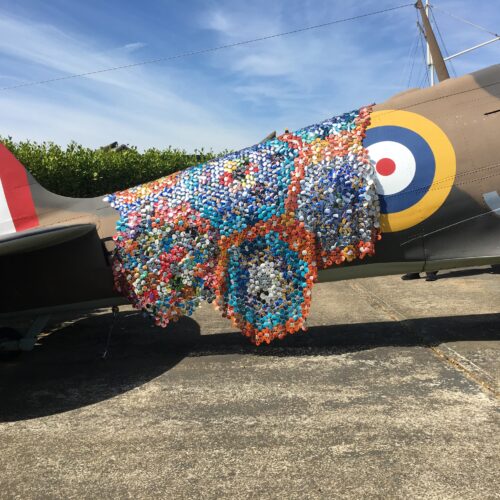
Creativity, art, craft, design and process: all of it!
The Heatherwick study visit was a real eye opener. It was the most fabulous exhibition, and its hard to encapsulate what it was about, and why it was so splendid. Thomas Heatherwick runs a maverick studio that designs architecture, urban plans, chairs, tables, objects of all kinds. (The Heatherwick Studio designed the Olympic Cauldron, an expandible bag made of zips, a playful spinning top chair for example). As the exhibition catalogue says his work defies classification. The fact that a lot of it is about architecture and the design of objects is irrelevant to its usefulness as a means of learning how to think creatively and develop ideas. What is so notable about the way he/his studio works is the degree of experimentation and play involved in the germination of designs. The the outcomes are about form and function there is a real blurring of boundaries between art, craft and design. I found it fascinating that the studio often works on ideas with no brief, comes up with the germ of something and then perhaps holds it for months and years before matching it with a client brief.
What is so notable about the way he/his studio works is the degree of experimentation and play involved in the germination of designs. The the outcomes are about form and function there is a real blurring of boundaries between art, craft and design. I found it fascinating that the studio often works on ideas with no brief, comes up with the germ of something and then perhaps holds it for months and years before matching it with a client brief.
Do browse Heatherwick’s website under images and look at the range of projects: small, medium and large. What you’ll miss on here is what the exhibition provides, a real insight into the working methods, the creative drive and the design process of Heatherwick and his studio.
Although we promoted this visit to textiles students in particular, it is a pity it didn’t attract more students from a range of subjects, though, of course, all those who turned up had a great day.
See below for the reflections of OCA tutor Liz Smith on the day.
My visit to this intriguing and thought provoking exhibition at the V&A made me re-examine my thinking in terms of the creative process in the light of the work of this talented designer. His solutions to design problems are both highly creative and innovative. He states that for him, his interest is generated by the materials themselves and their physical properties, or by direct exploration of the engineering process. This initial exploration or playing with ideas for him seems to mark the beginning or preparation for creative thought and a willingness and ability to ‘think outside the box.’ As with all creative thought, ideas need time to germinate and what was so interesting about this exhibition was that this incubation process was so well documented. This allowed the visitor to gain valuable insights into how the designer consistently rejected conventional solutionsto design briefs and subsequently established new connections and ways of working in order to develop inventive and original solutions to design challenges. In all his designs, there was a sense of a ‘Eureka’ moment when an idea finally crystallised as a viable working possibility.

Heatherwick defines the creative process as ‘a focussed choosing rather than designing. ’ He acknowledges the extent to which he further rationalises his ideas in order to meet functional requirements and this allows him to successfully implement his ideas in real terms. For me, his creativity is characterised by his seeming referenceto an eclectic range of historical, cultural and aesthetic sources as evidenced by the ‘Throne’ chair, where the form itself appeared to simultaneously pay homage to the garden furniture of Edward Lutyens and Michael Thonet’s bentwood chairs, together with Heatherwick’sown playful reference to the sprung construction of old prams! In terms of his architectural designs, I was also intrigued by the various ways in which his buildingsmade such a direct and literal connection with the surrounding landscape. This was clearly evident in one of his smaller scale projects, the East Beach Café which drew directly on the organic form of the waves and shingle as inspiration for the architectural form itself, both externally and internally. The way in which the two interrelated to support each other visually and texturally was very exciting to see.
In the final analysis, what impressed me most was his ability to marry form and function in such a creative way. What other designer do you know who could simultaneously design a functioning bridge which would then roll up to create a free standing sculptural form?






What a talented man/studio! I was really impressed with the design for the new London bus. Heatherwick has taken something which is very familiar and used his originality to make it very different, so much more curvaceous and rather beautiful. What a thrill it must have been to receive one of the Christmas cards. Thank you for arranging this visit and the opportunity to meet fellow students and discuss what we had seen.
This was my first study visit and I enjoyed it very much. Not only was the exhibition fabulous and informative it opened new ways to think and work and I also met some fellow students. Jane, James and Liz were great and I enjoyed listening to their views and being able to contribute my own. If all study visits are like this I can’t wait for the next one!
Disappointed to have missed this – I am a textile student but was not aware of the visit – It sounds as if it was truly fascinating